Eston Creates the First All-Domestically Produced Heavy Load Robot Stamping Line for Automotive Body Panels in China
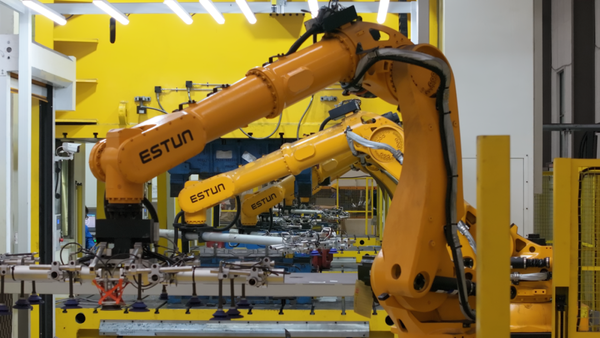
In the automotive manufacturing field, stamping process is the core link in the production of body panels (such as doors, side panels, engine hoods, etc.). Traditional stamping lines rely on manual loading and unloading, facing issues such as low efficiency, harsh working conditions (noise, high temperature, dust), and safety hazards. Meanwhile, the rise in labor costs and the loss of young workers have intensified the urgency for the industry to transform towards automation. According to market research, the penetration rate of industrial robots in the stamping process has been increasing year by year, especially against the backdrop of the rapid development of new energy vehicles. High-load, high-precision, and high-stability stamping automation solutions have become key demands for car manufacturers to reduce costs and increase efficiency.
In response to industry pain points, Estun successfully delivered the first domestically produced heavy-load robot automotive panel stamping line in China, marking a significant breakthrough in domestic stamping automation technology. This solution achieved full-line integrated control, covering the entire process from depalletizing, cleaning, stamping to handling. In the manufacturing of new energy vehicle bodies, this solution, through high-precision positioning and multi-robot collaboration, addressed the issues of unstable rhythm and high material loss caused by equipment response delays and low efficiency in process connections in traditional processes, helping automakers achieve lightweight and carbon reduction goals.
heavy load stamping line complete solution
Estun has been deeply involved in the field of stamping automation since its establishment, relying on 30 years of technological accumulation to build a full industrial chain capability from core components to complete line integration. Its independently developed ER150-3200-PR high-load stamping dedicated robot is specifically designed for large-load stamping scenarios such as automotive body panel stamping.
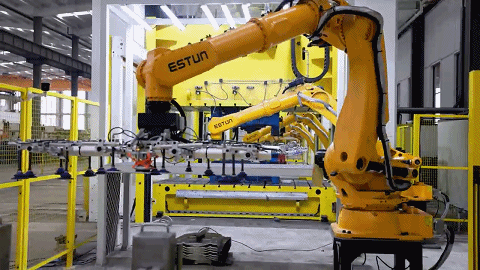
1
Super large load and high adaptability: Optimization of robot wrist moment of inertia, adaptable to large-sized panels, multi-panel stacking, and large press spacing scenarios, meeting the automotive industry's demand for efficient handling of large body panels.
2
High-speed precise motion control: By fine-tuning the robotic kinematic parameters and self-developed dynamic algorithms, optimized stamping trajectories are achieved, with operation beats reaching 10-12 times per minute (SPM), significantly improving production line efficiency.
3
Stability and reliability: After rigorous running-in tests, the robot can operate at high speed continuously without failure, adapting to the 7x24 hour high-load production demands of the automotive industry.
4
Software and hardware collaborative innovation: Combining Estun's self-developed stamping software application package with the press control system (PAC series) to achieve synchronized control of the entire line and flexible configuration of process parameters, reducing the complexity of debugging
Central control system empowers efficient manufacturing
Estun's fully domestically produced large-load robot automotive stamping line central control system is the core intelligent hub of the production line, coordinating the collaborative operation of robots, presses, and auxiliary equipment in real-time through an integrated control architecture. The system centrally collects and analyzes full-process data including the operational signals of the press, the motion status of the robots, safety interlock signals, and more, making dynamic decisions based on preset logic and issuing commands to achieve a full-link closed-loop management from order parsing, recipe calling, production execution to safety monitoring, ensuring efficient connection and precise synchronization of processes such as depalletizing, stamping, and handling.
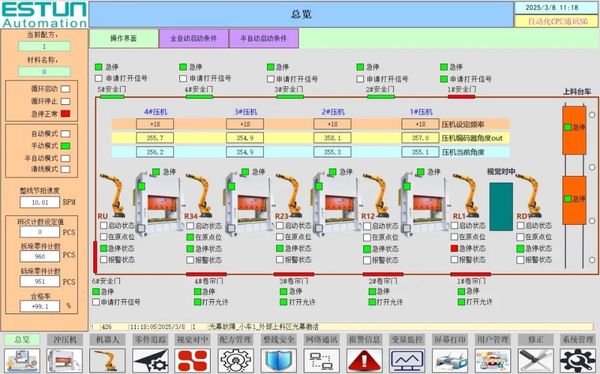
1
Intelligent production scheduling and collaborative control: By automatically adjusting the production rhythm to adapt to product types and mold switching needs, maximizing equipment utilization; while coordinating the action timing of robots, presses, conveyors, and other equipment, achieving seamless integration of multiple devices, significantly improving the operational efficiency of the production line.
2
Real-time monitoring and proactive maintenance: Integrating networked monitoring and AI algorithms, real-time collection of equipment operation data and tracking of part locations, combined with threshold warnings and fault predictions, for rapid response to anomalies; supports remote operation and maintenance debugging and software upgrades, significantly reducing downtime and ensuring production continuity.
3
Data-driven decision optimization: Automatically match process parameters based on orders, and issue precise production instructions; record key indicators such as output, yield, and energy consumption, and generate visual reports (such as OEE analysis) to provide data support for process optimization and resource scheduling, assisting in lean management.
4
Multi-level security protection system: adopts multiple interlocking mechanisms such as grating and safety PLC, combined with role permission control and key data redundancy design, to comprehensively prevent misoperation and system failures, ensuring high reliability of the production line and the safety of personnel and equipment.
Digital Construction of Intelligent Stamping New Ecosystem
Estun stamping digital production line, online realization of production orders, equipment status, and production efficiency data processing and display. Edge computing modules work in concert with the E-Noesis industrial digital platform, bringing precise and intuitive equipment management, lean and intelligent production process management, as well as fast and convenient after-sales service.
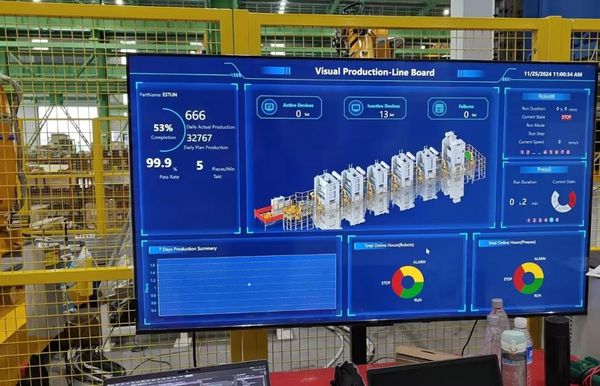
1
Stamping equipment status real-time monitoring: dynamically displays part name, daily planned output, current output, production rhythm, and batch pass rate, using data feedback to drive dynamic optimization of the production system, achieving visualized production process and controllable quality.
2
Robot operation status tracking: Real-time monitoring of robot running/stopped/ emergency stop/alarm status, operating mode (single step/continuous), speed adjustment, and other key parameters to ensure standardized robot operations and reduce the risk of abnormal downtime.
3
Press stability monitoring: accurately displays the press operating status (running/stopped/emergency stop/alarm), working frequency, and other data to ensure efficient and stable operation of the equipment.
4
Efficient collaborative after-sales service support: Relying on the edge-side collection of equipment operation data and platform-end analysis capabilities, it supports remote fault diagnosis and maintenance guidance, shortening the service response cycle and reducing operation and maintenance costs.
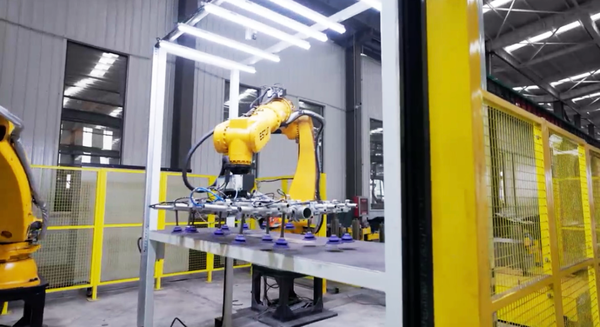
Estun, with its independently controlled core technology and fast-response localized services, takes the leading position in the wave of domestic substitution. In 2024, Estun's market share ranks first among Chinese domestic industrial robot brands, and the coverage of its stamping solutions in the automotive, home appliance, and hardware fields continues to increase.
Estun's heavy-duty stamping line solution not only fills the gap in domestic high-end stamping equipment but also promotes the transformation of the automotive manufacturing industry towards intelligence and green with its features of high efficiency, stability, and flexibility. In the future, as domestic robot technology further advances and application scenarios deepen, Estun is expected to write a new chapter in global competition.
【Copyright and Disclaimer】The above information is collected and organized by PlastMatch. The copyright belongs to the original author. This article is reprinted for the purpose of providing more information, and it does not imply that PlastMatch endorses the views expressed in the article or guarantees its accuracy. If there are any errors in the source attribution or if your legitimate rights have been infringed, please contact us, and we will promptly correct or remove the content. If other media, websites, or individuals use the aforementioned content, they must clearly indicate the original source and origin of the work and assume legal responsibility on their own.
Most Popular
-

List Released! Mexico Announces 50% Tariff On 1,371 China Product Categories
-

Nissan Cuts Production of New Leaf EV in Half Due to Battery Shortage
-

New Breakthrough in Domestic Adiponitrile! Observing the Rise of China's Nylon Industry Chain from Tianchen Qixiang's Production
-

Dow, Wanhua, Huntsman Intensively Raise Prices! Who Controls the Global MDI Prices?
-

Mexico officially imposes tariffs on 1,400 chinese products, with rates up to 50%






